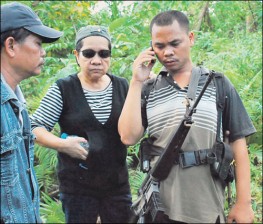Agusan hostage talks bog down
PROSPERIDAD, Agusan del Sur—A tribal leader whose imprisonment prompted the abduction by his Manobo followers of 16 teachers and students on Friday was freed temporarily Sunday to help negotiate the release of the hostages, authorities reported.
Three hours after Ondo Perez was released to help in the negotiations, the kidnappers freed two of their hostages—identified as Agusan del Sur school superintendent Hipolito Lastimado and teacher Diosdado Cabantac—to travel on a motorcycle to get food, water and medicine.
In return for the provisions, officials appealed to the hostage-takers to free two children—a 13-year-old boy and a 10-year-old girl who was stricken with fever, police said.
“They threatened to harm the remaining hostages if the two will not return,” Senior Supt. Nestor Fajura told the Associated Press (AP). “We’ve assured them the two will be back.”
Lastimado and Cabantac were intercepted by police and taken to a crisis management committee headquartered in a wooden house at Barangay La Purisima 3 kilometers from the kidnappers’ forested encampment.
Officials declined comment on the release of the two hostages or say if they would be sent back with supplies to the kidnappers. At nightfall, Lastimado and Cabantac were still with officials behind closed door.
Article continues after this advertisementBefore the two emerged from the forested area, where they had been held along with at least 14 other hostages since Friday, Perez talked with his brother Allan, who was among six kidnappers. Perez was accompanied by negotiator Josefina Bajade and several government escorts.
Article continues after this advertisementThe kidnappers have demanded the release of Perez, who was jailed for taking 79 people hostage in 2009 over a long-running clan feud in Agusan.
Empty-handed
The AP said a local court had temporarily freed Perez to urge the gunmen to end the standoff peacefully, according to police officials.
At 12:15 p.m., Perez and the negotiator came out of a meeting with the kidnappers empty-handed, Inquirer reporters were told.
Perez, who wore a white T-shirt, shorts and slippers, appeared to be talking with Bajade and arguing with his police escorts.
Perez was visibly irked, but the reason was unclear.
“Negotiations temporarily bogged down, but the crisis committee remained optimistic that the hostage-taking incident will be resolved through peaceful means,” Chief Insp. Nelly Villagarcia said.
It was unclear if the release of Lastimado and Cabantac was a result of the intervention of Perez.
Police sources said the two hostages were freed to forage for food but were intercepted by troops and taken to the crisis committee.
Food and water were delivered on Saturday to the hostage-takers, the AP said. Police sharpshooters and Army soldiers have been deployed near the hostage scene. The kidnappers were armed with an M-16 rifle, a shotgun and a pistol.
The 16 hostages were seized as they were walking along a main road from graduation ceremonies at three schools. They were taken aboard two motorcycle taxis to a hilly hinterland.
Palace hands off
“This is tragic because these are lowly paid teachers who are being held,” said Prosperidad Mayor Alvin Magdamit. “They worked hard to prepare for the graduation ceremonies and ended being hostaged.”
The latest hostage-taking erupted seven months after a kidnapping crisis in Manila ended in bloodshed when a dismissed policeman commandeered a busload of Hong Kong tourists to demand his job back.
The Aug. 23, 2010, standoff before international TV cameras ended with police and the gunman opening fire, leaving eight hostages and the kidnapper dead and earning the Aquino administration ridicule for ineptitude.
President Benigno Aquino III’s deputy spokesperson, Abigail Valte, said the Palace was “closely monitoring” the incident but was leaving negotiations to local officials.
“We’re confident we are going to have a good resolution,” Valte told government radio dzRB.
She said the “paramount concern” of the government was to ensure the safety of the hostages.
“We’d rather let the local crisis committee stay in charge of the matter because its members are there and they are the ones doing the negotiations. We will just wait for the resolution,” Valte said.
No timeline
Mayor Magdamit said authorities would try to resolve the crisis peacefully.
“I don’t have a timeline because the outcome is still in the hands of the negotiators, but we are very hopeful that we will be able to resolve the issue soon,” Magdamit said.
Perez and three of his men were jailed for the kidnapping of 79 people in 2009—a result of simmering tribal rivalry. Government negotiators had then promised not to arrest Perez and his men if he freed his hostages, who also included children.
But police detained the abductors after the hostages were released after four days.
The kidnappers in the current crisis are all relatives of Perez, Magdamit said.
Julius Mabandos, chair of the Caraga-based Alliance of Lumad in Mindanao, said the negotiation was doomed to fail because the government, particularly the Office of the National Commission on Indigenous Peoples (NCIP), was insincere in dealing with the lumads.
“Had the NCIP and politicians showed sincerity and fairness in addressing the issue of ancestral land titling, poverty and economic opportunity, this would not have happened in the first place,” he said.
2009 deal
Aside from asking the government to release Perez, the gunmen wanted the government to implement the agreement signed during the 2009 hostage-taking incident, which said the Perez clan’s ancestral domain claims would be processed.
“The government treated the lumad like kids with false promises and will only act whenever crisis like this surfaces, a lesson for the government to learn from,” Mabandos said.
He suggested that the problem be resolved through the tribal judicial system.
“Allow tribal elders to interfere and negotiate with kidnappers and do not involve in talks personalities long discredited by the Manobos,” he suggested. With reports from Christine O. Avendaño in Manila, Associated Press and Agence France-Presse
